Jimmy Carter facts for kids
Quick facts for kids
Jimmy Carter
|
|
|---|---|
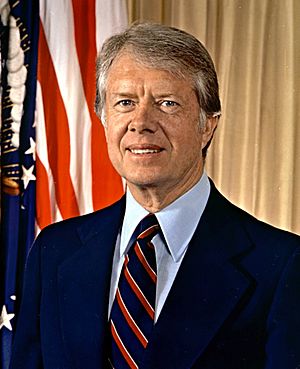
Official portrait, 1978
|
|
| 39th President of the United States | |
| In office January 20, 1977 – January 20, 1981 |
|
| Vice President | Walter Mondale |
| Preceded by | Gerald Ford |
| Succeeded by | Ronald Reagan |
| 76th Governor of Georgia | |
| In office January 12, 1971 – January 14, 1975 |
|
| Lieutenant | Lester Maddox |
| Preceded by | Lester Maddox |
| Succeeded by | George Busbee |
| Member of the Georgia State Senate from the 14th district |
|
| In office January 14, 1963 – January 9, 1967 |
|
| Preceded by | Constituency established |
| Succeeded by | Hugh Carter |
| Personal details | |
| Born |
James Earl Carter Jr.
October 1, 1924 Plains, Georgia, U.S. |
| Died | December 29, 2024 (aged 100) Plains, Georgia, U.S. |
| Political party | Democratic |
| Spouse | |
| Children | 4, including Jack and Amy |
| Parents |
|
| Relatives | Carter family |
| Education | United States Naval Academy (BS) |
| Civilian awards | Full list |
| Signature |  |
| Military service | |
| Branch/service | United States Navy |
| Years of service |
|
| Rank | Lieutenant |
| Battles/wars | World War II |
| Military awards | |
James Earl Carter Jr. (October 1, 1924 – December 29, 2024) was an American politician and humanitarian who served as the 39th president of the United States from 1977 to 1981.
Historians and polls have assigned mixed ratings to Carter's presidency, but his post-presidency period (the longest in U.S. history) has received near-universal praise, including a Nobel Peace Prize in 2002.
Contents
Early life
Carter was born on October 1, 1924, in Plains, Georgia. He was the oldest son of Bessie Lillian (née Gordy) and James Earl Carter Sr. The family moved a lot when Carter was an infant.
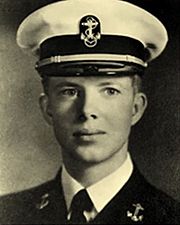
Carter attended the Plains High School from 1937 to 1941. He also joined the Future Farmers of America and developed a lifelong interest in woodworking.
After high school, Carter went to Georgia Southwestern College, in Americus, Georgia. He graduated from the United States Naval Academy with a Bachelor of Science degree in 1946.

After graduating from Annapolis, Jimmy Carter served in the U.S. Navy. He was a nuclear submarine officer, and although he never saw combat during the war, his service instilled in him a strong sense of duty and discipline.
On December 12, 1952, an accident with the experimental NRX reactor at Atomic Energy of Canada's Chalk River Laboratories resulted in millions of liters of radioactive water flooding the reactor building's basement. This left the reactor's core ruined. Carter was ordered to Chalk River to lead a U.S. maintenance crew that joined other American and Canadian service personnel to assist in the shutdown of the reactor. The painstaking process required each team member to don protective gear and be lowered individually into the reactor for 90 seconds at a time, limiting their exposure to radioactivity while they disassembled the crippled reactor. When Carter was lowered in, his job was simply to turn a single screw. During and after his presidency, Carter said that his experience at Chalk River had shaped his views on atomic energy and led him to cease development of a neutron bomb.
Carter served in the U.S. Navy for seven years. When his father died in July 1953, Carter decided to return to Plains to take over the family's peanut farm. He left active duty on October 9, 1953.
His awards include the American Campaign Medal, World War II Victory Medal, China Service Medal, and National Defense Service Medal. As a submarine officer he also earned the "dolphin" badge.
Farming
Being an agri-businessman proved to be difficult but Carter was determined to expand the family's peanut-growing business. When his first-year harvest failed due to a drought, Carter had to open several bank lines of credit to keep the farm afloat. Meanwhile, he took classes and studied agriculture while his wife Rosalynn learned accounting to manage the business's books. Though they barely broke even the first year, the Carters grew the business and became quite successful.
Early political career (1963–1971)
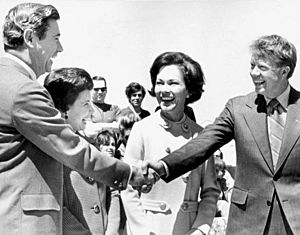
Carter's political career began in the Georgia State Senate. He served there from 1963 to 1967. Then, he became the Governor of Georgia, from 1971 to 1975. During his time as governor, he focused on improving education and environmental protection. He tackled many important issues like improving the state's education system and protecting its natural resources.
Civil rights were a high priority for Carter. He added black state employees and portraits of three prominent black Georgians to the capitol building: Martin Luther King Jr., Lucy Craft Laney, and Henry McNeal Turner. He also favored a constitutional amendment to ban busing, and co-sponsored an anti-busing resolution at the 1971 National Governors Conference.
Presidency (1977–1981)

As a dark-horse candidate not well known outside of Georgia, Carter won the Democratic nomination and narrowly defeated incumbent Republican president Gerald Ford in the 1976 U.S. presidential election.
Carter was inaugurated as the 39th president on January 20, 1977. He pardoned all Vietnam War draft evaders on his second day in office. He created a national energy policy that included conservation, price control, and new technology. Carter successfully pursued the Camp David Accords, the Panama Canal Treaties, and the second round of Strategic Arms Limitation Talks. He also confronted stagflation. His administration established the U.S. Department of Energy and the Department of Education. The end of his presidency was marked by the 1979–1981 Iran hostage crisis, the 1979 energy crisis, the Three Mile Island accident, the Nicaraguan Revolution, and the Soviet invasion of Afghanistan. In response to the invasion, Carter escalated the Cold War by ending détente, imposing a grain embargo against the Soviets, enunciating the Carter Doctrine, and leading the multinational boycott of the 1980 Summer Olympics in Moscow. He lost the 1980 presidential election in a landslide to Republican nominee Ronald Reagan.
Post-presidency (1981–2024)
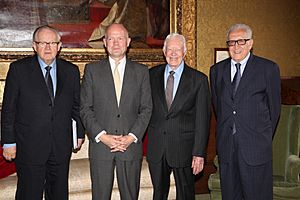
After leaving the presidency, Carter established the Carter Center to promote and expand human rights, earning him a Nobel Peace Prize in 2002. He traveled extensively to conduct peace negotiations, monitor elections, and further the eradication of infectious diseases. Carter was a key figure in the nonprofit housing organization Habitat for Humanity and wrote numerous books, ranging from political memoirs to poetry.
Personal life
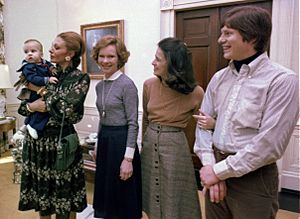
Carter married Rosalynn Smith in 1946. They had three sons, Jack, James III, and Donnel; one daughter, Amy; nine grandsons (one of whom is deceased), three granddaughters, five great-grandsons, and eight great-granddaughters.
On October 19, 2019, Carter and Rosaline became the longest-wed presidential couple, having overtaken George and Barbara Bush at 26,765 days.
Carter's hobbies included painting, fly fishing, woodworking, cycling, tennis, and skiing. He also had an interest in poetry.
Carter was a personal friend of Elvis Presley.
Death
Carter entered hospice care several months before celebrating his 99th birthday. He said in a 2019 interview with People that he never expected to live as long as he had and that the best explanation for longevity was a good marriage.
Carter died at his home in Plains, Georgia, on December 29, 2024, at the age of 100.
Interesting facts about Jimmy Carter
- Jimmy Carter was the only U.S. president to have been a licensed nuclear engineer.
- He was the longest-lived U.S. president and the only one to reach 100 years of age
- Carter was a skilled painter and painted hundreds of pictures, many of which depict scenes from his life and travels.
- He and his wife Rosalynn were married for over 75 years, a testament to their enduring love.
- He was known for his Sunday school teaching, a tradition he continued even after leaving the White House.
Jimmy Carter quotes
- "To be true to ourselves, we must be true to others."
- "Wherever life takes us, there are always moments of wonder."
- "We should live our lives as though Christ were coming this afternoon."
- "We have to inspire our children and grandchildren to take on challenges and risks that at first may seem to be overwhelming, or even impossible. They need to understand that the only failure is not trying."
- "America did not invent human rights. In a very real sense… human rights invented America."
- "You only have to have two loves in your life: for God, and for the person in front of you at any particular time."
- "Earlier in my life, I thought the things that mattered were the things that you could see, like your car, your house, your wealth, your property, your office. But as I’ve grown older I’ve become convinced that the things that matter most are the things that you can’t see—the love you share with others, your inner purpose, your comfort with who you are."
- "We must adjust to changing times and still hold to unchanging principles."
- "We are of course a nation of differences. Those differences don't make us weak. They're the source of our strength."
Timeline
- 1924: Born in Plains, Georgia.
- 1946: Graduated from the U.S. Naval Academy.
- 1953: Left the Navy and returned to Plains.
- 1963-1967: Served in the Georgia State Senate.
- 1971-1975: Served as Governor of Georgia.
- 1976: Elected President of the United States.
- 1977-1981: Served as President of the United States.
- 1982: Established The Carter Center.
- 2002: Awarded the Nobel Peace Prize for his decades of work promoting peace and human rights.
- 2024: Died in Plains, Georgia, on December 29, 2024, at the age of 100.
Legacy
Although Carter's presidency was unpopular, his peace and humanitarian works since he left office made Carter one of the most popular former presidents in American history.
On February 21, 2024, the White House Historical Association unveiled its official 2024 White House Christmas ornament honoring Carter's naval service and efforts for peace. This was the first time a president being honored was alive at the time of the unveiling.
Images for kids
-
The Carter family store, part of Carter's Boyhood Farm, in Plains, Georgia
-
Newly elected governor of Arkansas and future president Bill Clinton meets with President Carter in 1978
-
Carter signing the Airline Deregulation Act, 1978
-
Carter standing alongside Israeli Prime Minister Menachem Begin, during his 1979 visit
-
First Lady Rosalynn Carter, Tanzanian leader Julius Nyerere, and Carter, 1977
-
Deng Xiaoping with President Carter
-
Carter with King Hussein of Jordan and Shah of Iran in 1977
-
Carter and Leonid Brezhnev signing the SALT II treaty at the Hofburg Palace in Vienna, June 18, 1979
-
Carter, Israeli Prime Minister Menachem Begin and Zbigniew Brzezinski in September 1978
-
The state funeral of George H. W. Bush in December 2018. Carter and his wife Rosalynn can be seen on the far right of the photograph.
-
Carter in Plains, Georgia, 2008
See also
 In Spanish: Jimmy Carter para niños
In Spanish: Jimmy Carter para niños


















